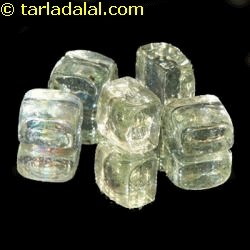![]()
Description
Ice is a solid phase, usually crystalline, of a non-metallic substance that is liquid or gas at room temperature, such as carbon dioxide ice (dry ice), ammonia ice, or methane ice. However, the predominant use of the term ice is for water ice. It can appear transparent or opaque bluish-white color, depending on the presence of impurities or air inclusions. The most common phase transition to ice occurs when liquid water is cooled below 0°C (273.15K, 32°F) at standard atmospheric pressure. Ice cubes are produced domestically by filling an ice cube tray with water and placing it in a freezer. Many freezers also come equipped with an icemaker, which produces ice cubes automatically and stores them in a bin from which they can be dispensed directly into a glass. Ice cubes out of a tray are generally longer and thinner, requiring less force to remove them from the tray and thereby reducing the likelihood of the cube becoming stuck in the dispenser.
Ice tubes
While the usual shape of the ice 'cube' is roughly cubical, there are trays that dispense hemispherical or cylindrical blocks. These are commonly referred to as ice tubes.
Coarsely crushed Ice
Ice can be crushed coarsely using a hammer. Ice cubes can also be crushed or sheared into irregularly-shaped flakes, adding an interesting aesthetic effect to some cocktails. Crushed ice is also used when faster cooling is desired, since the rate of cooling is governed by the number and average radius of the ice particles.
Finely crushed ice
Usually a crusher is used to crush ice finely. Finely crushed ice melts quicker, and makes more of a slushy drink-perfect for summer coolers.
Ice-cubes

Ice cubes are small, roughly cube-shaped pieces of ice, conventionally used to cool beverages. Ice cubes are often preferred over crushed ice because they melt more slowly; they are standard in mixed drinks that call for ice, in which case the drink is said to be "on the rocks'.
How to select
Ice cubes are also produced commercially and sold in bulk; these ice cubes, despite their name, are often cylindrical, and may have holes through the center. An interesting characteristic of commercially made ice cubes is that they are completely clear, lacking the clouding found in the center of domestically made ice cubes. Cloudy ice cubes result when water is frozen quickly, or ice is allowed to form on the surface of the water.
Culinary uses
· Add ice cubes or crushed ice in cocktails.
· Crushed ice is used for making daiquiris, slush, cold coffee, milk shakes, etc
· Add ice cubes to make iced tea, cool fruit juices or several mocktails.
How to store
Store ice in deep freezer in trays or in suitable plastic ice containers. Recent demand for premium, safe drink ice has created a new niche market for disposable ice trays which can be cost- effectively transported or stored at room temperature.
Health benefits
· There are no substantial health benefits associated with ice.